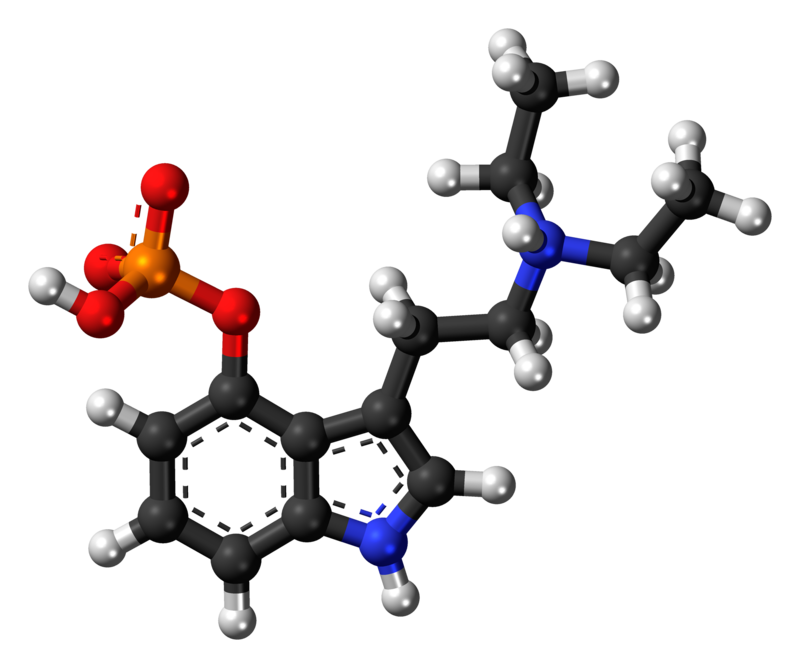Contents
Summary
Ethocybin, also known as CEY-19 or 4-phosphoryloxy-DET, is a semi-synthetic psychedelic alkaloid belonging to the tryptamine family. This compound shares structural similarities with psilocybin, a natural alkaloid found in certain mushrooms. Ethocybin’s psychoactive effects are akin to those of shorter LSD or psilocybin experiences. However, the specific intensity and duration of these effects can vary based on factors such as dosage, individual physiology, and the individual’s mental state and physical surroundings.
| Identifiers | |
|---|---|
| IUPAC name | |
| CAS Number | 60480-02-6 |
|---|---|
| ChemSpider | 21106438 |
| UNII | Z47K2YT973 |
| CompTox Dashboard (EPA) | DTXSID80705541 |
| Chemical and physical data | |
| Formula | C14H21N2O4P |
| Molar mass | 312.306 g·mol−1 |

Chemistry
Similar to psilocybin, miprocybin, and metocybin, ethocybin is a prodrug, meaning it undergoes conversion into the active compound ethocin within the body through a process called dephosphorylation. This transformation can occur in strongly acidic environments or enzymatically with the assistance of phosphatases present in the body.
Albert Hofmann, renowned for his discovery of psilocin and psilocybin, was also the first to synthesize this compound. He introduced it to the market using the codename CEY-39.
Pharmacology
Much like psilocybin, ethocybin undergoes rapid dephosphorylation within the body, converting it into 4-HO-DET. This metabolite acts as a partial agonist at the 5-HT2A serotonin receptor in the brain, producing effects that resemble serotonin (5-HT).
Medicine
Ethocybin has been the subject of research for various disorders since the early 1960s, and numerous scientific publications have explored its properties. Its short duration of action has been seen as an advantage. A study conducted in 2010 suggested that Ethocybin may offer therapeutic benefits for individuals with bipolar affective disorder.

Effects
Ethocybin is absorbed through the oral and stomach lining. Its effects typically commence within 20 to 45 minutes after ingestion and may persist for 2 to 4 hours, varying based on the dosage, species, and individual metabolism. In comparison to psilocybin, the effects of ethocybin tend to be somewhat shorter in duration.
Pharmacology
Ethocybin is believed to undergo its primary metabolism in the liver, where it is converted into ethocin. It is also broken down by the enzyme monoamine oxidase, but further research is needed to understand the metabolic process fully.
Regarding tolerance, both mental and physical tolerance to ethocybin build up and diminish rapidly. Using ethocybin more than three or four times a week, particularly on consecutive days, can lead to reduced effects. However, tolerance tends to dissipate after a few days. Thus, frequent users often space their doses five to seven days apart to prevent a diminished effect.
Legality
Ethocybin is not regulated in the United States at the federal level. However, it’s important to note that possession or sale may potentially be subject to legal scrutiny under the Federal Analog Act.
FAQ
- What is Ethocybin?
- Ethocybin, also known as CEY-19, is a semi-synthetic psychedelic alkaloid of the tryptamine family. It is closely related to the mushroom alkaloid psilocybin and is considered a prodrug for 4-HO-DET (ethocin) in the body.
- How does Ethocybin work?
- Like psilocybin, Ethocybin is dephosphorylated in the body, primarily in the liver, to form 4-HO-DET (ethocin). This compound acts as a partial agonist at the 5-HT2A serotonin receptors in the brain, leading to psychedelic effects.
- What are the effects of Ethocybin?
- The effects of Ethocybin are similar to a shorter LSD or psilocybin trip. However, the intensity and duration of these effects can vary depending on the dosage, individual physiology, and the user’s environment (set and setting).
- How is Ethocybin administered?
- Ethocybin is usually taken orally, with effects beginning approximately 20-45 minutes after ingestion. The duration of these effects typically lasts from 2 to 4 hours.
- Are there any potential therapeutic uses for Ethocybin?
- Research on Ethocybin as a treatment for various disorders dates back to the 1960s. Some studies have explored its potential in the treatment of conditions like bipolar affective disorder.
- What is the legal status of Ethocybin in the United States?
- Ethocybin is not controlled or scheduled at the federal level in the United States. However, it’s important to be aware that its possession or sale may be subject to scrutiny under the Federal Analog Act.
- Is there a risk of tolerance with Ethocybin use?
- Yes, like other psychedelics, both mental and physical tolerance to Ethocybin can develop quickly. Taking Ethocybin more than a few times a week, especially on consecutive days, may lead to diminished effects. Tolerance usually dissipates within a few days.
- What is the onset of Ethocybin effects, and how long do they last?
- Ethocybin’s effects typically start within 20-45 minutes after ingestion and can last from 2 to 4 hours, which is somewhat shorter compared to psilocybin.
- What is the ideal dosing frequency for Ethocybin to avoid tolerance?
- To prevent tolerance and maintain the desired effects, users often space their Ethocybin doses at intervals of five to seven days.
- Is Ethocybin the same as psilocybin or psilocin?
- Ethocybin is related to psilocybin and psilocin but is a distinct compound. It acts as a prodrug for 4-HO-DET (ethocin) and exhibits its unique effects.
References
- “NCATS Inxight: Drugs — 4-PHOSPHORYLOXY N,N-DIETHYLTRYPTAMINE”. drugs.ncats.io. Retrieved 2020-01-22.
- Gartz J (1989). “Biotransformation of tryptamine derivatives in mycelial cultures of Psilocybe”. Journal of Basic Microbiology. 29 (6): 347–52. doi:10.1002/jobm.3620290608. PMID 2614674. S2CID 43308695.
- “EMCDDA | Hallucinogenic mushrooms profile (chemistry, effects, other names (magic mushrooms, shrooms…), origin, mode of use, other names, medical use, control status)”. www.emcdda.europa.eu. Retrieved 2020-01-22.
- US patent 3075992, Hofmann, Albert; Troxler, Franz., “Esters of indoles”, issued 1963-1-29.